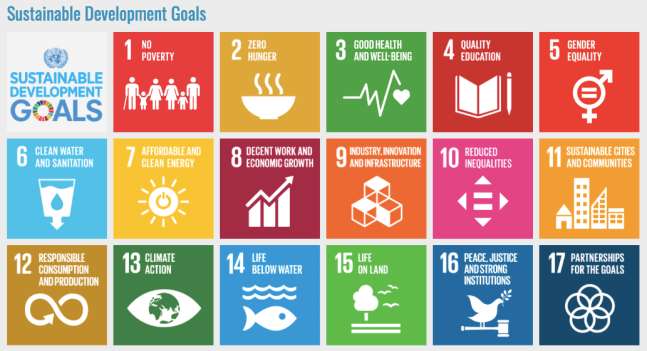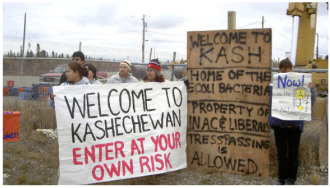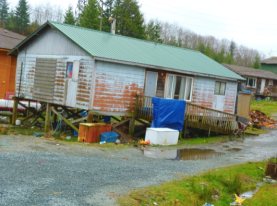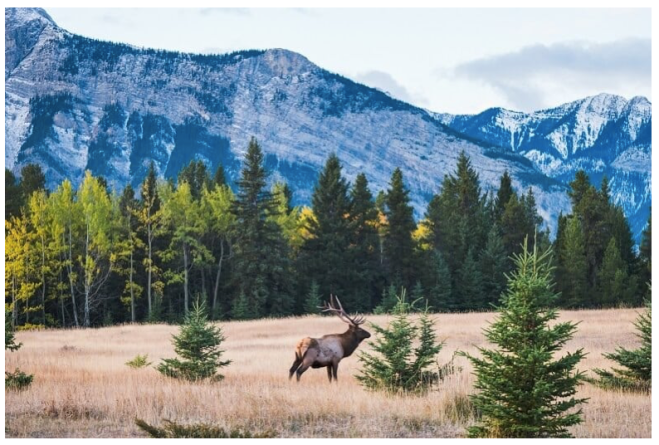Part 1: Question
How does Truth and Reconciliation in Canada relate to the UN’s Sustainable Development Goals?
In order to meet the UNs Sustainability goals, we must work towards Truth and Reconciliation. According to Sanchez and Vaughan of the International Institute for Sustainable Development, Canada is currently failing to meet these 17 goals, especially in Indigenous communities. According to the Canada without Poverty website, “the residential school system has left in its bloody wake a legacy of intergenerational trauma and systemic poverty.” In Canada, one-quarter of Indigenous people live in poverty. This is especially true for those living on reserves. The average unemployment rate on reserves is 50% and the rate raises as high as 90% in some communities.
“Poverty can only be solved by tackling inequalities.”
We are also have an unreasonably high level of food insecurity in Canada. Nearly half of poor Indigenous households face food insecurity. That number rises even higher in Nunavut, where 69% of Inuit adults are living with food insecurity (six times higher than the national average)! Related to this issue is the cost of food on Canadian reserves. For example, on the Kashechewan First Nations Reserve in northern Ontario, one report by TVO current affairs, lists a $30 frozen pizza, $15 for a carton of eggs, $13.42 for a bag of apples, and $12.89 for a head of red cabbage.
A personal example of this is when my mother-in-law went to visit a friend in Churchill. My mother-in-law was shown around the land by these friends and in return she asked what she could bring to them from Winnipeg. Out of all the possible things they could have requested, all they asked for was fresh produce. And so, my mother brought in her suitcase 50 pounds of produce. I have also heard from people who used to live in Churchill about the ridiculously high prices of food – never mind healthy, fresh food, even unhealthy food is unaffordable. How are people living in poverty in these communities supposed to afford food that most middle class people would have trouble affording? This just does not seem right to me.
The effects of poverty and food insecurity play a huge role in poor health outcomes which are then exacerbated by limited health care resources in Indigenous communities. For example, rates of STIs, obesity, infant mortality, and suicide rates among the Indigenous population exceed the national rates (Canada without Poverty). It is also well-known that there is a disproportionate number of Indigenous individuals with diabetes. According to a recent study by Firestone, et.al, the rate of diabetes among Indigenous individuals living in urban areas was found to be 3 times higher than the overall population. Incidents of tuberculosis was found to be 17 times higher than the overall Canadian population.
Indigenous communities in Canada are also disproportionately affected by poor housing, schooling, and drinking water (Sanchez & Vaughan). For example, it has been reported that 73% of drinking water treatment systems on reserves are at high or medium risk of contamination and 50.9% of homes are contaminated with mold and mildew (Canada without Poverty).
Another issue involves gender inequality and the fact that there is an extraordinarily high number of missing and murdered Indigenous women in this Country. This is a complete contrast to the high status, influence, and powerful roles women held in many First Nations in the past (trc.ca page 1-2).
According to the International Institute for Sustainable Development website, “The recommendations of the Truth and Reconciliation Commission require urgent action”. In order to meet sustainability in each of the three pillars – economic, social, and environmental – we must work towards reconciliation.
Reconciliation involves establishment and maintenance of a mutually respectful relationship between Aboriginal and non-Aboriginal people in Canada (trc.ca, page 6). It has also been stated by many Indigenous people, specifically by Elder Reg Crowshoe , that in order for reconciliation to occur, there must be reconciliation with the earth as well (trc.ca, page 18).
I agree with what Prime Minister Justin Trudeau said at the UN General Assembly:
Here in Canada most of the population is able to enjoy a high standard of living, but we also have an unacceptably high rate of poverty, health issues, and environmental challenges (Sanchez & Vaughan). I think that many people are able to see the problems going on in Canada, and there is desire for change and progress. In order to address these issues, and work towards a better future, we need to work towards equality and focus on creating a better future for generations to come. I think that we have a real opportunity to make changes in Canada. 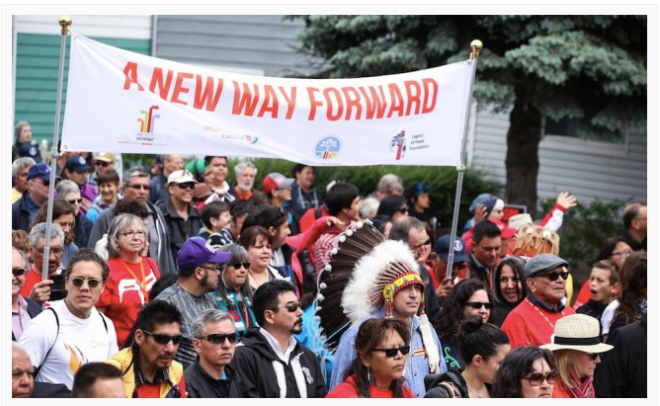
In the Ted Talks video by Micheal Green, he speaks about what it takes to meet the UN’s sustainable development goals. I found it very interesting to learn that, although economic growth is a factor in sustainability, increases in GDP does not equate to increases in social progress and social sustainability. For example, it was shown that Costa Rica and New Zealand are not the richest countries and only have modest GDPs, however they are maintaining high levels of social progress. I completely agree that governments need to prioritize the well-being of its people and we as individuals need to demand it.
“Eradicating Poverty embodies a universal vision for peace, prosperity, and dignity for all people on a healthy planet”
Part 2 : Watch
How did the information presented in the talks above affect how you think about nature?
What aspects of nature and biodiversity do you feel are most important to protect? How can you take action to protect this aspect?
AFFECT on my thinking: I never really stopped to think about the inter-connectedness of nature. Watching the first video, How tress talk to each other– Ted Talk, Suzanne Simard, I was interested to learn about “mother trees” and the underground networks that occur between the tree roots and mycorrhizal fungi. I also loved learning about how mother trees provide nutrients and information to seedlings! I always knew trees were important for air quality, for humans, animals, and insects, as well as being aesthetically pleasing among other benefits. However, I did not truly realize the important roles they play for the health of the ecosystems, species, and genetic diversity around them. I have learned that trees, especially these old mother trees, are essential to the life and systems around them. It is already painful to think about the overwhelming amount of deforestation going on around the world, but it is especially hard when you know how special these organisms are.
Here is a link to a website about the importance of trees! 
“Approximately 90% of all vascular land plants live in some association with mycorrhizal fungi. Mycorrhizal associations are seen in the fossil record and are believed to be one of the contributing factors that allowed early land plants, including Aglaophyton major (one of the first land plants), to conquer the land.”
– International Plant Science Center website

 The second video, Why I love vultures– Ted Talk, Munir Virani, changed my view on vultures. I always thought of vultures as disease carrying, unappealing birds, but after watching this video I was able to appreciate this species. It was interesting to learn how important vultures are in preventing the spread of diseases. I recently finished watching a documentary on feral street dogs in India and the dangers they come with as carriers of rabies. Without the presence of vultures to clean up carcasses in the area, feral dogs are attracted and bring with them the danger of rabies. As much as I love dogs, I definitely see how much more vultures offer to nature in this way.
The second video, Why I love vultures– Ted Talk, Munir Virani, changed my view on vultures. I always thought of vultures as disease carrying, unappealing birds, but after watching this video I was able to appreciate this species. It was interesting to learn how important vultures are in preventing the spread of diseases. I recently finished watching a documentary on feral street dogs in India and the dangers they come with as carriers of rabies. Without the presence of vultures to clean up carcasses in the area, feral dogs are attracted and bring with them the danger of rabies. As much as I love dogs, I definitely see how much more vultures offer to nature in this way. 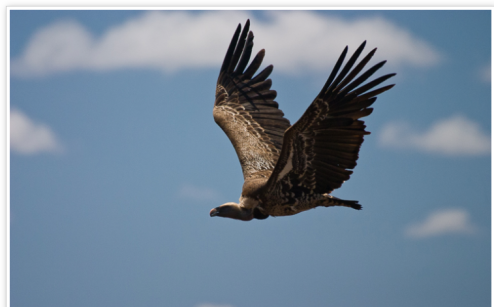 Vultures may not be the prettiest animals to look at, but that’s the beauty of nature. Just because they aren’t the most aesthetically pleasing to look at for most people, it has no effect on their value to nature. I have a new-found respect for vultures after watching this video. This also ties into anthropocentrism, biocentrism, and ecocentrism. I definitely see the value of all organisms and how inter-connected we all are.
Vultures may not be the prettiest animals to look at, but that’s the beauty of nature. Just because they aren’t the most aesthetically pleasing to look at for most people, it has no effect on their value to nature. I have a new-found respect for vultures after watching this video. This also ties into anthropocentrism, biocentrism, and ecocentrism. I definitely see the value of all organisms and how inter-connected we all are.
Most important aspects of BIODIVERSITY: This is a very hard question, especially after reflecting on the inter-connectedness of nature. Something as little as fungi, for example, play a huge role in the health of the ecosystem around it. Even if we were to only focus on the importance of mycorrhizae to trees, you can then argue about the importance of trees to air quality, and then air quality to all living things on Earth.
If I just focused on one aspect, I would have to say that protecting natural habitats is one of the most important things to focus on. My view on this was largely affected by what we have learned in class – in order to protect species, we need to protect their habitats.


here is a link to an interesting site about the biodiversity of coral reefs, from the Coral Reef Alliance website.
“The wide variety of species on Earth, whether they’re plants, animals or microscopic organisms, are vital to keep the world’s many ecosystems healthy, balanced and thriving”
“Biodiversity ensures natural sustainability for all life on the planet”
– 5 major threats to biodiversity, and how we can help curb them, by Matt Petronzio
Some ways that I can take action towards protecting natural habitats is to reduce my mark or “footprint”, educate myself and others around me, advocate for the protection of habitats, and join some of the existing groups (NGOs) that are already working towards protecting natural habitats.
Some ways I am currently taking action are through reducing my use of paper, printing materials, and plastics. I also try to buy local products, and choose free-trade and environmentally friendly products whenever possible.
Some other ways I can further reduce my mark, would be to drive less and walk or bike more. 
“What has become increasingly clear is that nature conservation must not only focus on areas with high numbers of different species; successful conservation also requires the protection of large, intact ecosystems. These places are becoming increasingly rare and are rapidly disappearing. A 2016 study found that the area of intact wilderness landscapes has shrunk to just 23 per cent of the planet, and has declined by 10 per cent since 1990.”
–Canada’s Biodiversity Can Change The World, by Dan Kraus
Part 3 : Action
Spend 1 hour in silence in nature and reflect on the following questions:
Describe where and when you spent your time in nature.
What did you experience in your time in nature? What did you see, hear, smell, feel? What effect did this time in nature have on you?
I spent one hour at the Assinaboine Forest park on a Monday afternoon. It was very calming listening to the leaves rustling in the wind and the birds chirping all around. Every once in a while I would hear an airplane flying overhead, but for the most part I was able to enjoy the sounds of nature.
I was suprised that I didn’t get to see many animals, but I am guessing this is due to the cold weather today! I did get to see some birds and a few bees though. I also really enjoyed looking at the fall-coloured leaves.
The breeze was nice and cool today, and very refreshing! I smelt a variety of “earthy” smells, especially a wet/damp soil type smell.
During this time I felt relaxed, happy, and calm. After the hour I felt surprisingly less stress and more positive. I enjoyed this hour in nature and am hoping to implement this on a daily/weekly basis!
Part 4 : In-class blog questions
Human Environment Connections
What promotes human connection to nature?
Spending time in nature promotes human connection to nature
What promotes disconnection from nature?
Electronics and screen time promotes disconnection from nature
Is there a danger to a growing disconnect from nature?
Yes, there is a danger to a growing disconnect from nature. If we don’t connect with nature we will care for it less. We tend to care for the things we connect with. Not getting out in nature, thereby creating a disconnect, means we will take less care of it.
Worldviews
Where do your environmental ethics lie?
Anthropocentric – Biocentric – Ecocentric
I would say that I am somewhere in between biocentric and ecocentric. I agree that every living thing has value, but I do think some things have more value than others. For example, although I think that bacteria and plants, etc. have value and are essential for nature – ecosystem, species, and genetic diversity – I do think that animals have more life value. But overall, I believe every organism has value and is important to Earth.
I enjoy nature because I care about animals, insects, trees, and other plants. Nature is aesthetically beautiful, but the whole system itself is intrinsically beautiful as well, regardless of the effect or impact it has on me, or humans in general.
Wildspaces
Can parks meet its dual mandate of access and protection?
I definitely think that parks can meet its dual mandate of action and protection.
I think that park protection has to take priority, and access should come second.
One thing that can be done for park protection could be to reduce the amount of residential and commercial buildings within the parks. By building further outside the parks, space does not have to be taken up and species do not need to be removed in order to create that space. This would also help reduce the problem of fragmentation.
Another thing that can be done would be to limit access to parks. This could be done, for example, by prohibiting vehicles from coming in too deep within these large parks. For example, instead of individuals driving in, offer walking, biking, bus tours, etc. to reduce the amount of roads that need to be made.
We can also extend the current laws of protection in place for federal parks to provincial parks. Decisions on protection should also be made by scientists rather than politicians.
The idea of creating city density could help in the protection of parks as well. By limiting the space cities take up, we can leave more space for natural environments.
How can this be achieved in Wapusk?
As I was researching more about this park on the National Geographic website to answer this question, I noticed there are many practices for protection already occurring. For example, access is very limited – it sounds very hard to get to, it is a very remote area, and unescorted travellers are not permitted to visit.
There can also be more public awareness and education on the interesting and important aspects of this park. Creating a connection to the park will help promote protection for it as well.
This is a park with both cultural and natural heritage and is an important area to protect.
– Brittny Turner, 7649754: Environmental Science 2000, University of Manitoba, September 24, 2018.
References: all sources, pictures, and video links can be viewed by clicking on the picture or underlined portion of text.
